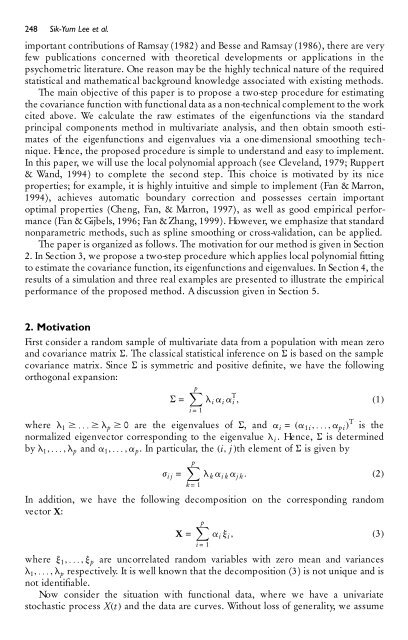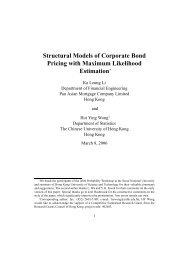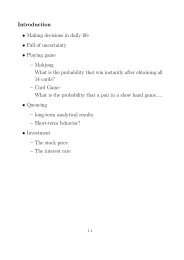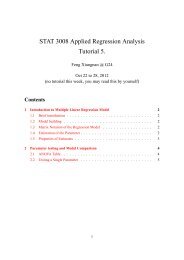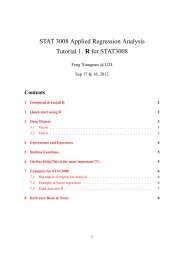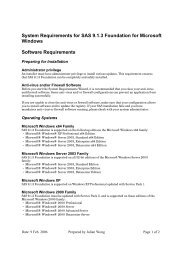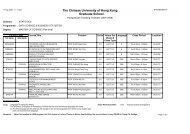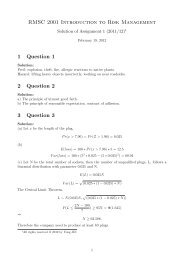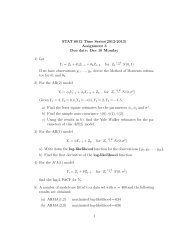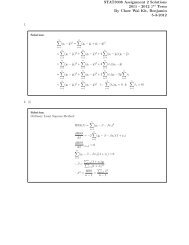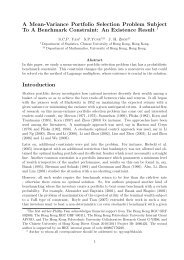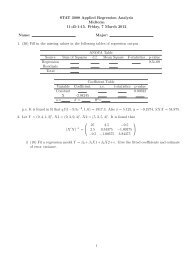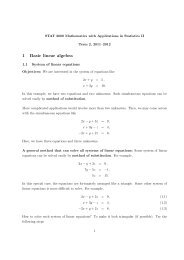Estimating the covariance function with functional data - Statistics ...
Estimating the covariance function with functional data - Statistics ...
Estimating the covariance function with functional data - Statistics ...
Create successful ePaper yourself
Turn your PDF publications into a flip-book with our unique Google optimized e-Paper software.
248 Sik-Yum Lee et al.<br />
important contributions of Ramsay (1982) and Besse and Ramsay (1986), <strong>the</strong>re are very<br />
few publications concerned <strong>with</strong> <strong>the</strong>oretical developments or applications in <strong>the</strong><br />
psychometric literature. One reason may be <strong>the</strong> highly technical nature of <strong>the</strong> required<br />
statistical and ma<strong>the</strong>matical background knowledge associated <strong>with</strong> existing methods.<br />
The main objective of this paper is to propose a two-step procedure for estimating<br />
<strong>the</strong> <strong>covariance</strong> <strong>function</strong> <strong>with</strong> <strong>function</strong>al <strong>data</strong> as a non-technical complement to <strong>the</strong> work<br />
cited above. We calculate <strong>the</strong> raw estimates of <strong>the</strong> eigen<strong>function</strong>s via <strong>the</strong> standard<br />
principal components method in multivariate analysis, and <strong>the</strong>n obtain smooth estimates<br />
of <strong>the</strong> eigen<strong>function</strong>s and eigenvalues via a one-dimensional smoothing technique.<br />
Hence, <strong>the</strong> proposed procedure is simple to understand and easy to implement.<br />
In this paper, we will use <strong>the</strong> local polynomial approach (see Cleveland, 1979; Ruppert<br />
& Wand, 1994) to complete <strong>the</strong> second step. This choice is motivated by its nice<br />
properties; for example, it is highly intuitive and simple to implement (Fan & Marron,<br />
1994), achieves automatic boundary correction and possesses certain important<br />
optimal properties (Cheng, Fan, & Marron, 1997), as well as good empirical performance<br />
(Fan & Gijbels, 1996; Fan &Zhang, 1999). However, we emphasize that standard<br />
nonparametric methods, such as spline smoothing or cross-validation, can be applied.<br />
The paper is organized as follows. The motivation for our method is given in Section<br />
2. In Section 3, we propose a two-step procedure which applies local polynomial tting<br />
to estimate <strong>the</strong> <strong>covariance</strong> <strong>function</strong>, its eigen<strong>function</strong>s and eigenvalues. In Section 4, <strong>the</strong><br />
results of a simulation and three real examples are presented to illustrate <strong>the</strong> empirical<br />
performance of <strong>the</strong> proposed method. A discussion given in Section 5.<br />
2. Motivation<br />
First consider a random sample of multivariate <strong>data</strong> from a population <strong>with</strong> mean zero<br />
and <strong>covariance</strong> matrix S. The classical statistical inference on S is based on <strong>the</strong> sample<br />
<strong>covariance</strong> matrix. Since S is symmetric and positive denite, we have <strong>the</strong> following<br />
orthogonal expansion:<br />
S = Xp<br />
i = 1<br />
l i a i a T i , (1)<br />
where l 1 $ . . . $ l p $ 0 are <strong>the</strong> eigenvalues of S, and a i = (a 1i , . . . , a pi ) T is <strong>the</strong><br />
normalized eigenvector corresponding to <strong>the</strong> eigenvalue l i . Hence, S is determined<br />
by l 1 , . . . , l p and a 1 , . . . , a p . In particular, <strong>the</strong> (i, j )th element of S is given by<br />
j i j = Xp<br />
k = 1<br />
l k a i k a j k . (2)<br />
In addition, we have <strong>the</strong> following decomposition on <strong>the</strong> corresponding random<br />
vector X:<br />
X = Xp<br />
i = 1<br />
a i y i , (3)<br />
where y 1 , . . . , y p are uncorrelated random variables <strong>with</strong> zero mean and variances<br />
l 1 , . . . , l p respectively. It is well known that <strong>the</strong> decomposition (3) is not unique and is<br />
not identiable.<br />
Now consider <strong>the</strong> situation <strong>with</strong> <strong>function</strong>al <strong>data</strong>, where we have a univariate<br />
stochastic process X(t) and <strong>the</strong> <strong>data</strong> are curves. Without loss of generality, we assume


